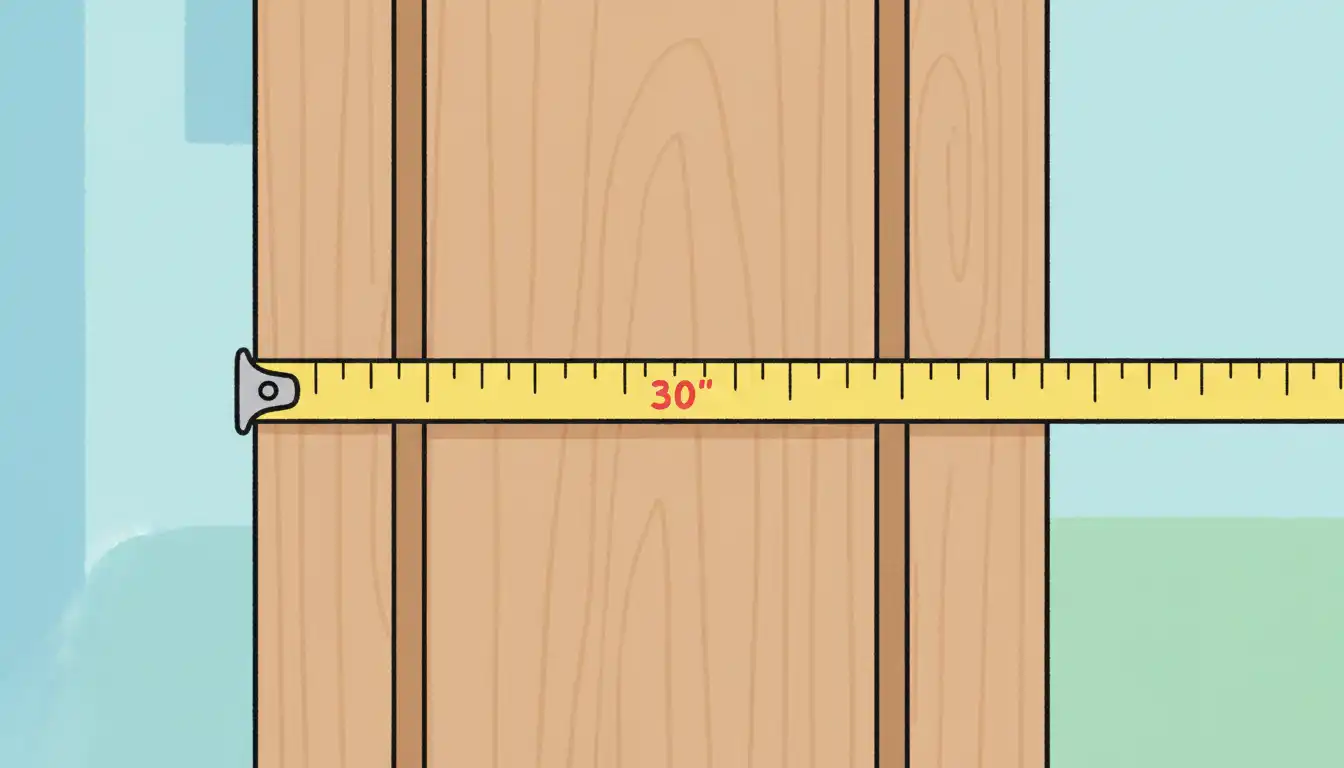Is a 30-Inch Door Really 30 Inches? The Truth Will Shock You
You have a tape measure in hand, ready to replace an old interior door. You measure the opening and head to the hardware store, confident you need a standard 30-inch door. But when you get it home, it doesn’t quite fit. This frustrating experience is one many homeowners face, leading to a critical question: is a 30-inch door really 30 inches wide?
The short answer is no. This discrepancy isn’t a manufacturing defect; it’s a long-standing industry standard that can cause significant confusion. Understanding the difference between a door’s “nominal” size and its “actual” size is the key to avoiding costly mistakes and ensuring your next door installation project is a success.
You'll Learn About
The Nominal vs. Actual Size Deception
In the world of construction and building materials, “nominal” refers to the name or label of a size, which is often a rounded number for convenience. The “actual” size is the precise, real-world measurement of the object. This concept applies to lumber (a 2×4 is actually 1.5″ x 3.5″), and it certainly applies to doors.
A door marketed as a “30-inch door” is its nominal size. Its actual width is typically slightly smaller, often measuring around 29 3/4 inches. This intentional reduction in size is crucial for proper door function.
Why Doors Are Undersized on Purpose
The primary reason for this undersizing is to create the necessary gaps for the door to operate smoothly. A door that was exactly the same size as its frame would be impossible to open or close. It would scrape, bind, and ultimately damage both the door and the frame.
These essential clearances, known as expansion gaps, allow the door to swing freely without friction. They also accommodate the natural expansion and contraction of the door and frame materials due to changes in temperature and humidity throughout the year. Without these gaps, a door that fits perfectly in the winter might become stuck shut during a humid summer.
Decoding Door Dimensions: Slabs vs. Pre-Hung Units
To fully grasp door sizing, it’s vital to differentiate between a door slab and a pre-hung door unit. Your measurement approach and what you purchase will depend heavily on which one you’re dealing with.
The Door Slab: Just the Door
A door slab is exactly what it sounds like: a single, rectangular slab of wood, composite, or metal without a frame, hinges, or hardware. When you buy a 30-inch door slab, you are buying the door itself. This slab will have the actual, slightly undersized dimensions (e.g., 29 3/4″ wide).
Replacing a slab is common when your existing door frame is in good condition and you simply want to update the door’s style. However, it’s a more challenging installation that requires precise mortising for hinges and drilling for the doorknob and latch. Getting the alignment perfect is critical for a smooth swing.
The Pre-Hung Door: An All-in-One System
A pre-hung door is a complete package. It includes the door slab already mounted on hinges within its own frame (the jambs). These units are designed to be installed directly into the rough opening in your wall.
When you buy a 30-inch pre-hung door, the “30-inch” label refers to the nominal size of the door slab itself. The entire unit, including the frame, will be larger to fit into a specific rough opening. This is often the preferred choice for new construction or when the existing door frame is damaged.
The Critical Role of the Rough Opening
The rough opening is the framed hole in the wall where the entire door unit will be installed. Its dimensions are paramount for a successful installation. For a pre-hung door to fit and function correctly, the rough opening must be larger than the door unit to allow for shimming and adjustments.
A standard rule of thumb is that the rough opening should be 2 inches wider and 2 to 2.5 inches taller than the nominal door size. This provides space for the door jambs (frame), plus room to plumb, level, and square the unit with shims. For a 30-inch door, you need a rough opening that is approximately 32 inches wide.

Common Sizing and Rough Opening Standards
Understanding these relationships is easier with a clear chart. Below is a breakdown of common interior door sizes and the corresponding actual slab widths and required rough opening dimensions.
| Nominal Door Size (Width x Height) | Actual Slab Width | Standard Rough Opening (Width x Height) |
|---|---|---|
| 24″ x 80″ | 23 3/4″ | 26″ x 82 1/2″ |
| 28″ x 80″ | 27 3/4″ | 30″ x 82 1/2″ |
| 30″ x 80″ | 29 3/4″ | 32″ x 82 1/2″ |
| 32″ x 80″ | 31 3/4″ | 34″ x 82 1/2″ |
| 36″ x 80″ | 35 3/4″ | 38″ x 82 1/2″ |
How to Measure Correctly for a Replacement Door
Accurate measurements are non-negotiable. A small error can lead to a door that doesn’t fit, wasting time and money. Follow these steps to measure for a replacement door slab.
Step 1: Measure the Width
Using a tape measure, check the width of your existing door slab in three places: top, middle, and bottom. It’s not uncommon for older doors to be slightly warped or out of square. Record the largest of the three measurements.
This measurement will likely be slightly under the whole number, such as 29 3/4 inches for a nominal 30-inch door. This is the actual dimension you need to match.
Step 2: Measure the Height
Measure the height of the door slab from the top edge to the bottom edge on both the left and right sides. Again, use the largest measurement. The standard height for most interior doors is 80 inches.
Step 3: Measure the Thickness
Finally, measure the thickness of the door. Most modern interior doors are 1 3/8 inches thick, while exterior doors are typically 1 3/4 inches thick. It’s crucial to match this dimension to ensure the new door fits correctly within the existing jamb stops and is compatible with the hinge mortises.
What If Your Frame is Not Standard?
In older homes, it’s common to find door frames that don’t conform to modern standards. You might discover your opening is an unusual size, which complicates a simple replacement. If you encounter this, you have a few options.
Custom Door Orders
If your measurements are non-standard, you may need to order a custom-sized door. This is a more expensive option, but it ensures a perfect fit without having to modify the existing frame. Many door manufacturers and specialty woodshops offer this service.
Modifying the Door Frame
For those with advanced DIY skills, modifying the rough opening to fit a standard pre-hung door is a viable solution. This involves removing the old frame and trim, adjusting the studs, and installing a new pre-hung unit. While more labor-intensive, it can be more cost-effective than a custom door and brings your home up to modern standards.
After installing a new frame, you may find small gaps between the frame and the wall or flooring. This is a perfect scenario where adding trim can provide a clean finish. A product like quarter round around the door frame is excellent for concealing these imperfections and creating a professional look.
Beyond the Basics: Factors That Influence Door Fit
Several other factors can impact the fit and function of your door, extending beyond the basic measurements. Paying attention to these details can prevent future headaches.
Hinge and Latch Placement
When replacing just the door slab, the location of the hinge mortises (the recessed areas where hinges sit) and the bore hole for the doorknob and latch must match the existing frame precisely. If they don’t, you will need to fill the old mortises with wood filler and chisel new ones, a task that requires precision.
Door Swing (Handing)
Door handing refers to the direction the door swings. To determine the handing, stand in the hallway facing the door. If the hinges are on the left and the door swings away from you into the room, it’s a left-hand door. If the hinges are on the right and it swings away, it’s a right-hand door. Ordering the correct handing is essential, especially for pre-hung doors.
The Impact of Flooring
The type and thickness of your flooring can affect the gap at the bottom of the door. If you are installing new, thicker flooring like high-pile carpet or tile, you may need to trim the bottom of the door to prevent it from dragging. Always account for finished floor height in your measurements.
A properly installed exterior door often requires a solid, level surface to prevent water ingress and provide stability. If you’re upgrading your entryway, consider if the area outside is adequate. Sometimes, you may need a durable concrete pad for your doorstep to ensure a long-lasting and stable installation.
Final Thoughts: The Secret is in the Details
So, is a 30-inch door really 30 inches? No, and that’s by design. This intentional undersizing is a crucial feature that allows for smooth, lifelong operation. The confusion between nominal and actual sizes is a common hurdle, but with the right knowledge, it’s one you can easily overcome.
The key to any successful door project lies in meticulous measurement and a clear understanding of your specific needs. Whether you’re installing a simple slab or a full pre-hung unit, taking the time to measure correctly and account for the rough opening will save you from the frustration of a poor fit. And for other entry points to your home, like a patio, you might consider modern solutions for convenience and comfort, such as a high-quality retractable screen door that offers fresh air without the bugs.
By demystifying the language of door dimensions, you can approach your next home improvement project with the confidence of a professional, ensuring a perfect fit and flawless function every time.

